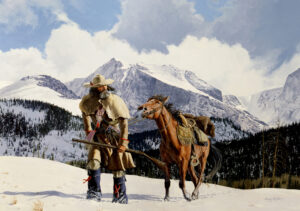The Virginia Historical Society saves one of the last remaining examples of large-scale Civil War imagery.
Near the top of a huge painting, a conservator stands on a lift, wielding something that resembles a cotton swab. She rubs the tip carefully on the canvas, removing roughly a century’s worth of grime one square inch at a time. In doing so, she is helping to reveal an iconic Civil War image as it was always meant to be seen. Her painstaking work is part of a multi year effort by the Virginia Historical Society to restore its massive murals depicting the Four Seasons of the Confederacy.
Painted by Frenchman Charles Hoffbauer between 1913 and 1920, these are the largest extant works of Civil War art aside from the renowned cycloramas at Gettysburg and Atlanta’s Grant Park. Over the decades, these masterpieces have suffered a host of problems—soot, grime, cigar smoke, dripping ceiling paint, flaking and blistering paint layers and even damage done during previous conservation efforts. Thanks to a $375,000 grant from the Save America’s Treasures program (now defunct), the society commissioned the Richmond Conservation Studio to undertake a complete restoration.
Hoffbauer was perhaps the last great master of the mural era. His work was well known in both America and France when the Confederate Memorial Association commissioned him to produce the murals for Battle Abbey, as the building that now houses the historical society was once known. Located on the grounds of a large retreat and rest home for Confederate veterans, the building was conceived as a shrine to the Lost Cause.
Under the watchful eye of the very men whose experiences he was depicting, Hoffbauer painted four large wall-size murals, one for each season of the Confederacy. Viewed together, almost like a cyclorama, the paintings begin with the springtime hopefulness of soldiers marching past Stonewall Jackson, followed by a fictitious summertime gathering of Confederate generals, then an autumn scene showing a J.E.B. Stuart cavalry charge and ending with a wintertime image of struggling soldiers and broken horses, exhausted by the war. Four smaller flanking murals depict other aspects of the conflict, including naval action and civilian life.
“These murals are meant to be allegorical,” says Paul Levengood, VHS president and CEO. “They’re also more intimate than, say, the Gettysburg Cyclorama. Don’t get me wrong; they did a wonderful job bringing that back [during its recent restoration], but the painting is kept at a distance. Here the faces are right there. There’s an immediacy about it that is pretty enthralling.”
Hoffbauer was notoriously finicky about his creative process, producing numerous sketches, mock-ups and models before he put brush to canvas. Then too, almost as soon as the Battle Abbey project began Hoffbauer was called away to serve in World War I. When he returned, armed with firsthand knowledge of battle fatigue and death on the battlefield, there is evidence that he scraped down what he had begun on the murals and started over, to create more realistic images of warfare.
As an initial step, the team from Richmond Conservation, led by principal conservator Cleo Mullins, studied archival photos and sketches to determine Hoffbauer’s original intent and see how the murals had changed over time, especially during previous restorations in the 1940s and 1960s. Cleaning methods had been abrasive, and some areas of loss had been heavily “inpainted,” so the perspective and positioning of some elements were dramatically altered.
Mullins and her team then photographed the paintings under normal and special lighting. That was followed by cleaning and removal of previous layers of varnish, dirt and inpainting where possible, as well as sealing sections that were blistering and flaking. Once that’s done, conservators will apply a new layer of varnish, followed by careful inpainting of missing areas, then apply a final layer of varnish to create an “insulating layer” between the original piece and new additions. All this painstaking work is expected to be complete sometime this year, and will be accompanied by improvements to the gallery space and new interpretation explaining the conservators’ work.
Although some critics have decried the murals as glorifying the Confederacy, Levengood believes their brutal realism belies those charges. “These paintings were part of a specific time and place and social milieu,” he says. “Except for the one with the generals–the ‘Mount Rushmore’ piece–these paintings show ordinary soldiers. There’s suffering and humanity. When Hoffbauer shows combat, he doesn’t show the enemy. He chooses to show it just from that one vantage point. By making that choice, he’s not showing a glamorization of the war or a demonization of the enemy.”
Mullins notes: “Hoffbauer won the Prix de Rome. He had a long career and was in constant demand. These were his most significant works, and our goal is to make them whole again.”
Originally published in the February 2013 issue of Civil War Times. To subscribe, click here.




